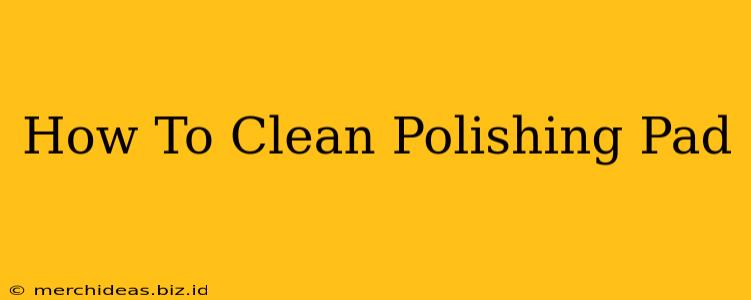Maintaining clean polishing pads is crucial for achieving professional-looking results and protecting your surfaces. Dirty pads can scratch, smear, and leave residue, ruining your hard work. This guide will walk you through various methods for cleaning different types of polishing pads, ensuring they're ready for your next project.
Understanding Polishing Pad Types and Their Cleaning Needs
Before diving into cleaning methods, it's important to identify the type of polishing pad you're working with. Different materials require different cleaning approaches. Common types include:
-
Foam Pads: These are versatile and commonly used for various applications. They're generally softer and more susceptible to damage from harsh cleaning methods.
-
Wool Pads: Known for their aggressive cutting power, wool pads require careful cleaning to preserve their longevity and prevent matting.
-
Microfiber Pads: These pads are highly absorbent and effective at removing dust and debris. They are usually easy to clean.
-
Cotton Pads: These pads offer a balance between aggressiveness and gentleness, making them suitable for various polishing tasks.
Effective Cleaning Methods for Polishing Pads
The best cleaning method depends heavily on the type of pad and the level of soiling. Here’s a breakdown of effective techniques:
1. The Quick Rinse and Wipe Method (For Lightly Soiled Pads)
For pads only slightly soiled with dust or light residue, a simple rinse and wipe might suffice.
- How-to: Rinse the pad under lukewarm running water, gently squeezing out excess liquid. Wipe the pad with a clean cloth or paper towel to remove remaining residue. Allow the pad to air dry completely before storing. This method is best for foam, microfiber, and cotton pads.
2. The Soap and Water Deep Clean (For Moderately Soiled Pads)
This method is suitable for removing more stubborn residue and grime.
- How-to: Fill a bowl or bucket with lukewarm water and add a small amount of mild dish soap. Submerge the polishing pad and gently agitate it to loosen any embedded debris. Rinse thoroughly with clean water and squeeze out excess liquid. Allow to air dry completely. This is generally safe for foam, microfiber, and cotton pads. Avoid this method with wool pads as excessive moisture can damage the fibers.
3. The Specialized Cleaning Solution (For Heavily Soiled Pads)
For heavily soiled pads or those with stubborn compounds, consider using a specialized cleaning solution designed for polishing pads.
- How-to: Follow the instructions on the chosen cleaning solution carefully. These solutions usually involve soaking the pad for a period, scrubbing with a brush, and rinsing thoroughly. Again, allow complete air drying. This approach can be effective for most pad types, but always check compatibility with your specific pad material.
4. Cleaning Wool Pads: A Gentle Approach
Wool pads require a more delicate touch. Avoid harsh scrubbing or prolonged soaking.
- How-to: Gently brush off loose debris using a stiff-bristled brush. You can use a damp cloth to wipe away stubborn residue, but avoid excessive moisture. Allow the pad to air dry completely before storing.
Proper Storage and Pad Longevity
Proper storage prolongs the life of your polishing pads. Keep pads in a cool, dry place away from direct sunlight and extreme temperatures. This prevents premature wear and tear and keeps them clean for longer.
When to Replace Your Polishing Pads
Despite your best cleaning efforts, polishing pads will eventually wear out. Look out for these signs:
- Significant wear and tear: Frayed edges, significant thinning, or holes indicate the pad needs replacing.
- Ineffective polishing: If the pad no longer performs as well as it did initially, it's time for a new one.
- Persistent residue: If cleaning no longer removes the embedded residue effectively.
Replacing worn-out pads ensures you achieve the best possible results and avoid damaging the surfaces you're working on.
By following these tips, you can keep your polishing pads clean, prolong their lifespan, and maintain a high standard of polishing for all your projects. Remember, clean pads equal professional results!
